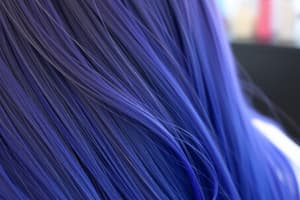Podcast
Questions and Answers
What is the main characteristic of semipermanent haircolor?
What is the main characteristic of semipermanent haircolor?
- It lifts the hair's natural color
- It is no-lift, deposit-only color (correct)
- It has a high molecular weight
- It contains a high amount of ammonia
How long does traditional semipermanent color typically last?
How long does traditional semipermanent color typically last?
- 3 to 5 shampoos
- 10 to 12 shampoos
- 6 to 8 shampoos (correct)
- 1 to 2 shampoos
What is the pH range of semipermanent haircolor?
What is the pH range of semipermanent haircolor?
- 9.0 to 11.0
- 5.5 to 6.5
- 4.0 to 5.0
- 7.0 to 9.0 (correct)
Which of the following is NOT a use of semipermanent haircolor?
Which of the following is NOT a use of semipermanent haircolor?
What is the main difference between semipermanent and demipermanent haircolor?
What is the main difference between semipermanent and demipermanent haircolor?
What is required before applying semipermanent haircolor?
What is required before applying semipermanent haircolor?
Which component is NOT typically found in semipermanent haircolor?
Which component is NOT typically found in semipermanent haircolor?
What does semipermanent haircolor do to the hair structure?
What does semipermanent haircolor do to the hair structure?
What is a characteristic of demipermanent haircolor?
What is a characteristic of demipermanent haircolor?
Which statement accurately describes the behavior of semipermanent color molecules?
Which statement accurately describes the behavior of semipermanent color molecules?
What type of test is required prior to applying semipermanent color?
What type of test is required prior to applying semipermanent color?
Which of the following is NOT a common use of semipermanent haircolor?
Which of the following is NOT a common use of semipermanent haircolor?
How does semipermanent haircolor affect the hair's pH?
How does semipermanent haircolor affect the hair's pH?
What is the duration of color retention for traditional semipermanent colors?
What is the duration of color retention for traditional semipermanent colors?
Which of the following components is NOT typically found in semipermanent haircolor?
Which of the following components is NOT typically found in semipermanent haircolor?
What couple of effects can semipermanent haircolor have on the hair?
What couple of effects can semipermanent haircolor have on the hair?
What is the primary characteristic of semipermanent color?
What is the primary characteristic of semipermanent color?
What is the result of the mild alkalinity in semipermanent haircolor?
What is the result of the mild alkalinity in semipermanent haircolor?
What is the typical pH range of semipermanent haircolor?
What is the typical pH range of semipermanent haircolor?
Which of the following is a use of semipermanent haircolor?
Which of the following is a use of semipermanent haircolor?
What is a key feature of demipermanent haircolor?
What is a key feature of demipermanent haircolor?
What testing is required prior to applying semipermanent haircolor?
What testing is required prior to applying semipermanent haircolor?
How long does semipermanent color typically last?
How long does semipermanent color typically last?
Which of the following is NOT a characteristic of semipermanent haircolor?
Which of the following is NOT a characteristic of semipermanent haircolor?
Flashcards are hidden until you start studying
Study Notes
Temporary Color Rinse
- Semipermanent colors are deposit-only, no-lift haircolor products designed to stain hair without altering its natural lightness.
- Smaller pigment molecules in semipermanent colors can partially penetrate the hair shaft and adhere to the cuticle layer.
- The color fades with each shampoo, typically lasting six to eight washes as molecules are gradually washed away.
Semipermanent Color
- Semipermanent color features a mildly alkaline chemical composition causing the hair cortex to swell and cuticle lifting for better penetration.
- It consists of small color molecules, solvents, alkaline swelling agents, and surfactants, resulting in a self-penetrating color.
- Requires a patch test to check for sensitivity or allergic reactions, especially due to the presence of aniline derivatives, as mandated by the FDA.
- Typically maintains a pH range of 7.0 to 9.0; services should follow with acid-balanced shampoos and conditioners to neutralize residual alkalinity.
- Uses include:
- Patching hair color
- Blending or covering partially gray hair while preserving natural color
- Covering up to 25% gray hair
- Enhancing or deepening existing hair color tones
- Acting as a non-peroxide toner for pre-lightened hair
Demipermanent Haircolor
- Demipermanent haircolors are also no-lift and deposit-only, offering longer-lasting results compared to semipermanent options.
- Designed specifically for depositing color without the ability to lighten hair.
Temporary Color Rinse
- Semipermanent colors are deposit-only, no-lift haircolor products designed to stain hair without altering its natural lightness.
- Smaller pigment molecules in semipermanent colors can partially penetrate the hair shaft and adhere to the cuticle layer.
- The color fades with each shampoo, typically lasting six to eight washes as molecules are gradually washed away.
Semipermanent Color
- Semipermanent color features a mildly alkaline chemical composition causing the hair cortex to swell and cuticle lifting for better penetration.
- It consists of small color molecules, solvents, alkaline swelling agents, and surfactants, resulting in a self-penetrating color.
- Requires a patch test to check for sensitivity or allergic reactions, especially due to the presence of aniline derivatives, as mandated by the FDA.
- Typically maintains a pH range of 7.0 to 9.0; services should follow with acid-balanced shampoos and conditioners to neutralize residual alkalinity.
- Uses include:
- Patching hair color
- Blending or covering partially gray hair while preserving natural color
- Covering up to 25% gray hair
- Enhancing or deepening existing hair color tones
- Acting as a non-peroxide toner for pre-lightened hair
Demipermanent Haircolor
- Demipermanent haircolors are also no-lift and deposit-only, offering longer-lasting results compared to semipermanent options.
- Designed specifically for depositing color without the ability to lighten hair.
Temporary Color Rinse
- Semipermanent colors are deposit-only, no-lift haircolor products designed to stain hair without altering its natural lightness.
- Smaller pigment molecules in semipermanent colors can partially penetrate the hair shaft and adhere to the cuticle layer.
- The color fades with each shampoo, typically lasting six to eight washes as molecules are gradually washed away.
Semipermanent Color
- Semipermanent color features a mildly alkaline chemical composition causing the hair cortex to swell and cuticle lifting for better penetration.
- It consists of small color molecules, solvents, alkaline swelling agents, and surfactants, resulting in a self-penetrating color.
- Requires a patch test to check for sensitivity or allergic reactions, especially due to the presence of aniline derivatives, as mandated by the FDA.
- Typically maintains a pH range of 7.0 to 9.0; services should follow with acid-balanced shampoos and conditioners to neutralize residual alkalinity.
- Uses include:
- Patching hair color
- Blending or covering partially gray hair while preserving natural color
- Covering up to 25% gray hair
- Enhancing or deepening existing hair color tones
- Acting as a non-peroxide toner for pre-lightened hair
Demipermanent Haircolor
- Demipermanent haircolors are also no-lift and deposit-only, offering longer-lasting results compared to semipermanent options.
- Designed specifically for depositing color without the ability to lighten hair.
Studying That Suits You
Use AI to generate personalized quizzes and flashcards to suit your learning preferences.





